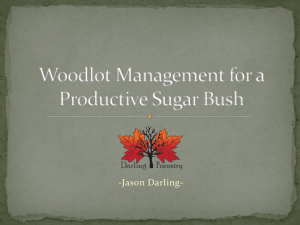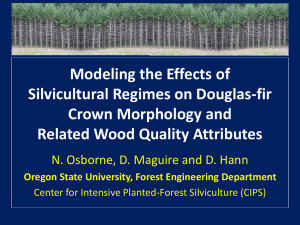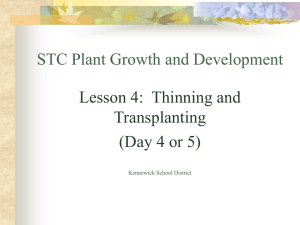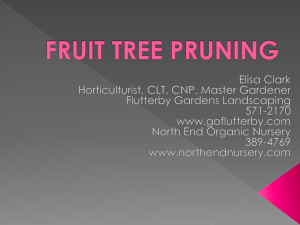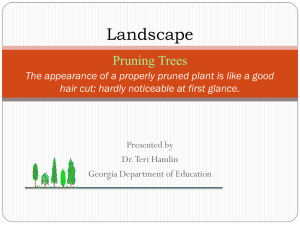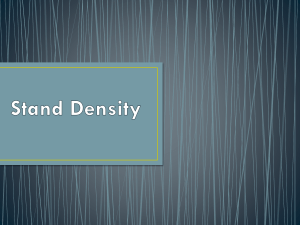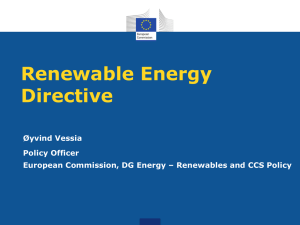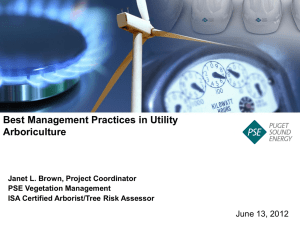Experiment thinning in Eucalyptus in Brazil
advertisement
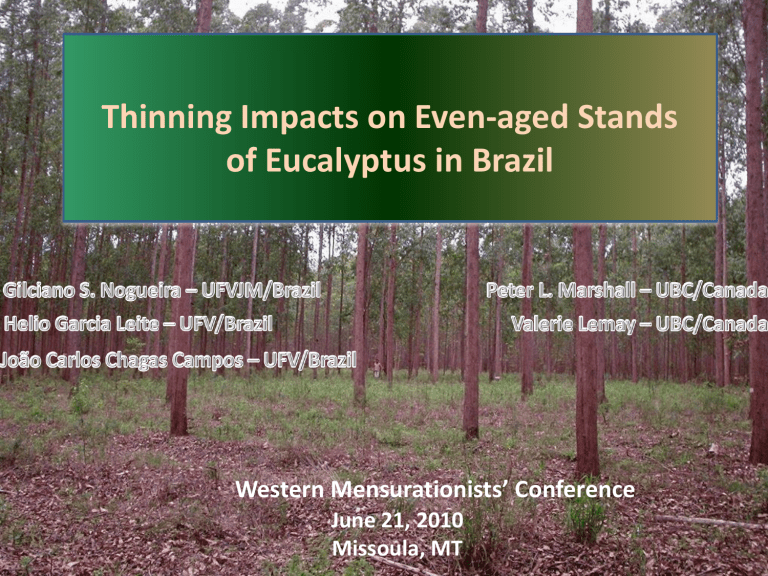
Thinning Impacts on Even-aged Stands of Eucalyptus in Brazil Western Mensurationists’ Conference June 21, 2010 Missoula, MT Introduction Plantation forest in Brazil: 6.6 million hectares, representing 0.8 % of the land area From 2004 to 2008 the area in eucalyptus plantation increased by 33.1%, or 1.1 million ha solid wood products is minimal Introduction Advances in wood technology and design have allowed various uses of eucalyptus wood as a solid product Introduction The demand for wood from large trees has been supported by illegal harvesting in native forests Consequently, there are also few studies on the impact of thinning in stands of eucalyptus in Brazil Introduction Thinning in eucalyptus forests can help increase Brazilian participation in the global market for solid wood products and may reduce pressure on Brazilian native forests Studies of thinning in eucalyptus are strategic for Brazil, both economically and environmentally Introduction An experiment was established to obtain a database reliable for analyzing the difference among thinning treatments and for developing growth and yield models for thinned eucalyptus stands Requirements: - Selection of the sample units was deliberate (selective sampling), so that representation of the medium and extreme site conditions is guaranteed - The sample units were sufficiently large to faithfully represent the silvicultural practices applied to the remainder of the stand Objective To analyze the effect of thinning on growth of stand variables in eucalyptus forests Overview of the experiment - Species: Eucalyptus grandis x Eucalyptus urophylla hybrid - Location: Northeast region of Bahia State, Brazil Overview of the experiment - Planting date: June/July 1993 - Date of installation of the permanent plots: September 1995 - Company: Bahia Specialty Cellulose (BSC) (http://www.bahiaspeccell.com) - Initial spacing between trees: 3.0 X 3.0 m - Thinnings accomplished: two selective thinnings, in 1998 and 2004 - Final harvest: at the end of 2007 Experimental Design - based on level-of-growing-stock installation standards - Located in 3 installations, comprising medium and good quality site conditions Experimental Design - Replicated randomized complete block with repeated measures - 6 blocks (two in each installation), each one involving two repetitions; - 4 treatments, corresponding to different basal area percentages removed in each thinning : Treatment 1: 20% without pruning; Treatment 2: 35% without pruning; Treatment 3: 50% without pruning; Treatment 4: 35% with pruning up to 6.0 meters; - Each block contained 8 permanent rectangular plots, with an area of 2,600 m2, totaling 48 plots (6 blocks x 2 repetitions x 4 treatments) Experimental Design - Layout C Block 1 A Block 1 B Block 1 Block 2 99,28 99,28 3 2 2 1 3 2 1 4 204,0 m 204,0 m Block 2 1 4 4 3 4 3 2 1 I II III IV 119.0 m 3 2 2 1 1 4 176.8 m 4 3 III IV Block 2 Experimental Design - Replicated randomized complete block with repeated measures - 6 blocks (two in each installation), each one involving two repetitions; - 4 treatments, corresponding to different basal area percentages removed in each thinning : Treatment 1: 20% without pruning; Treatment 2: 35% without pruning; Treatment 3: 50% without pruning; Treatment 4: 35% with pruning up to 6.0 meters; - Each block contained 8 permanent rectangular plots, with an area of 2,600 m2, totaling 48 plots (6 blocks x 2 repetitions x 4 treatments) - Plots were buffered by a few rows of trees on each side Marked boundaries of a plot Measurements - Data 1 2 3 4 Year of measurement 1995 1996 1997 1998 5 6 7 8 9 10 11 12 13 1999 2000 2001 2002 2003 2004 2005 2006 2007 Measurement Age (month) 27 40 50 Age (year) 61 75 87 100 111 124 136 147 157 164 5.1 6.3 7.3 8.3 9.3 10.3 11.3 12.3 13.1 13.7 2.3 3.3 4.2 Note before 1st thinning before 1st thinning before 1st thinning; 1st stem analysis (6 trees per dbh class) after 1st thinning after 1st thinning after 1st thinning after 1st thinning after 1st thinning after 1st thinning after 1st thinning after 2nd thinning after 2nd thinning after 2nd thinning; 2nd stem analysis (6 trees per dbh class) Measurements After 1st thinning (61 months) After 1st thinning (101 months) After 1st thinning (87 months) After 2nd thinning (165 months) Volume equation outside bark: LnVt -10.28859 1.751165Lndbh 1.23523LnHt R 2 0.998 inside bark: LnVt -10.39158 1.74249Lndbh 1.22368LnHt R 2 0.998 Volume equation outside bark Distribution of Raw residuals Predicted vs. Observed Values Expected Normal Predicted vs. Residual Scores Dependent variable: LnVtob 200 Dependent variable: LnVtob 180 0.0 0.20 160 -0.5 0.15 140 -1.0 0.10 120 -1.5 0.05 100 -2.0 0.00 80 -2.5 -0.05 60 40 20 0 -0.30 -0.25 -0.20 -0.15 -0.10 -0.05 0.00 0.05 0.10 0.15 0.20 -3.0 -0.10 -3.5 -0.15 -4.0 -0.20 -4.5 -4.5 0.25 Residuals 0.25 Observed Values No of obs 0.5 -4.0 -3.5 -3.0 -2.5 -2.0 -1.5 -1.0 -0.5 Predicted Values 0.0 -0.25 0.5 -5 -4 -3 95% confidence -2 -1 0 Predicted Values 95% confidence inside bark Distribution of Raw residuals Predicted vs. Observed Values Expected Normal Predicted vs. Residual Scores Dependent variable: LnVtib Dependent variable: LnVtib 0.25 180 -0.5 0.20 160 -1.0 0.15 140 -1.5 0.10 120 -2.0 0.05 100 -2.5 0.00 80 -3.0 -0.05 60 40 20 0 -0.30 -0.25 -0.20 -0.15 -0.10 -0.05 0.00 0.05 0.10 0.15 0.20 Residuals 0.0 Observed Values No of obs 200 -3.5 -0.10 -4.0 -0.15 -4.5 -0.20 -5.0 -5.0 -4.5 -4.0 -3.5 -3.0 -2.5 -2.0 Predicted Values -1.5 -1.0 -0.5 0.0 95% confidence -0.25 -5.0 -4.5 -4.0 -3.5 -3.0 -2.5 -2.0 Predicted Values -1.5 -1.0 -0.5 0.0 95% confidence Height equation Installation A LnHt -29.32738 0.42280 Ln Age - 0.00231Age 12.92836 LnSI -0.49355SI 0.64171Lndbh -0.01683dbh R 2 0.97 Installation B LnHt -38.23811 0.45930 Ln Age - 0.00238 Age 17.21817 LnSI 0.68722SI 0.54414 Lndbh - 0.01233dbh R 2 0.97 Installation C LnHt -32.40495 0.85823Ln Age - 0.00774 Age 12.67110 LnSI 0.41164 SI 0.81710 Lndbh - 0.03013dbh R 2 0.98 Height equation A Predicted vs. Observed Values Distribution of Raw residuals Expected Normal Dependent variable: LnHt Predicted vs. Residual Scores 0.20 700 3.4 0.15 600 3.2 0.10 500 3.0 0.05 400 2.8 0.00 300 2.6 -0.05 200 100 0 -0.20 -0.16 -0.12 -0.08 -0.04 0.00 0.04 0.08 0.12 0.16 0.20 Residuals 3.6 Observed Values No of obs 800 -0.10 2.4 -0.15 2.2 2.0 2.0 2.2 2.4 2.6 2.8 3.0 3.2 3.4 Predicted Values -0.20 2.0 3.6 2.2 2.4 2.6 2.8 3.0 3.2 Predicted Values 95% confidence 3.4 3.6 95% confidence B Predicted vs. Residual Scores Predicted vs. Observed Values Distribution of Raw residuals Expected Normal Dependent variable: LnHt Dependent variable: LnHt 0.20 700 3.4 0.15 600 3.2 0.10 500 3.0 0.05 400 2.8 0.00 300 2.6 200 100 0 -0.20 -0.16 -0.12 -0.08 -0.04 0.00 0.04 0.08 0.12 0.16 0.20 Residuals 3.6 Observed Values No of obs 800 2.4 -0.10 -0.15 2.2 2.0 2.0 -0.05 2.2 2.4 2.6 2.8 Predicted Values 3.0 3.2 3.4 3.6 95% confidence -0.20 2.0 2.2 2.4 2.6 2.8 Predicted Values 3.0 3.2 3.4 3 95% confiden Height equation C Distribution of Raw residuals Predicted vs. Residual Scores Predicted vs. Observed Values Expected Normal Dependent variable: LnHt Dependent variable: LnHt 400 3.6 0.20 350 3.4 0.15 3.2 300 0.10 3.0 0.05 250 2.8 0.00 200 2.6 100 50 0 -0.20 -0.16 -0.12 -0.08 -0.04 0.00 0.04 0.08 0.12 0.16 0.20 Residuals Observed Values No of obs 150 2.4 2.2 -0.10 -0.15 2.0 1.8 1.8 -0.05 2.0 2.2 2.4 2.6 2.8 Predicted Values 3.0 3.2 3.4 3.6 95% confidence -0.20 2.0 2.2 2.4 2.6 2.8 Predicted Values 3.0 3.2 3.4 3.6 95% confidence Growth trend Individual values Mean per treatment Growth trends Individual values Mean per treatment Growth trends Individual values Mean per treatment Growth trends Individual values Mean per treatment Analysis Variables: - periodic monthly increment (absolute): total height, dominant height, quadratic mean diameter and volume per tree - periodic monthly increment (percentage): basal area per hectare and volume per hectare Periods: A and B 1 2 3 (61 to 87) (87 to 137) (147 to 165) C 1 2 (61 to 87) (61 to 87) Analysis Anova: Mixed linear model, with thinning as the whole plot factor and period as the split-plot factor Fixed effect: thinning Random effect: block block*thinning Repetition(block*thinning) period period*thinning Pairwise comparisons: Bonferroni test Effect on periodic increment of average total height There is thinning effect A B A: only thinning 35% and thinning 35% + pruning were equal B and C : Only thinning 20% was different from the other treatments C Effect on periodic increment of dominant height No thinning effect Effect on periodic increment of quadratic mean diameter There is thinning effect A B A, B and C: only thinning 35% and thinning 35% + pruning were equal C Effect on periodic increment of basal area per hectare There is thinning effect A B A, B and C: only thinning 35% and thinning 35% + pruning were equal C Effect on periodic increment of volume per hectare There is thinning effect A B A, B and C: only thinning 35% and thinning 35% + pruning were equal C Effect on periodic increment of volume per tree There is thinning effect A B A, B and C: only thinning 35% and thinning 35% + pruning were equal C Conclusion No surprise! Conclusion Thinning affected the growth of total height, diameter, basal area per hectare, total volume per tree and total volume per hectare, but did not affect the growth of dominant height Thinning prevented regular tree mortality Prunning did not affect the growth trend of the variables analyzed nogueirags@gmail.com

